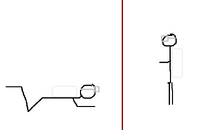newb diver here so i've never done a wall dive; i've been doing my descents w/my head up (i thought padi said that's the safest way to descend viz a viz equalization). should i change my descent do horizontal/head slightly down?
You may find equalization easier during the first 20' if you do it vertically. If you need to do that, then do it. After that you would probably find convenient and easy to go horizontal during the dive, including the portions where you are swimming along while gradually descending and ascending.
Sometimes, such as when going up and down a mooring line on a wreck, the ascent and descent are a very clearcut, separate phases of the dive. Either horizontal or vertical orientation will work for that, although staying horizontal makes control of ascent/descent rate easier since you have more drag in the vertical direction.
On a wall dive though, you often first descend 15 or 20' to get off the surface, then swim along the wall checking stuff out as you descend gradually towards your max depth. The ascent from a wall dive is often done very gradually, in several phases, such as 100' up to 70' then up to 50' then up to 30' --- taking several minutes at each depth and several minutes between depths. Obviously, the whole thing works much easier if you can control your buoyancy such that you gradually rise or fall while swimming along horizontally.
Another way to look at this vertical vs. horizontal ascent thing is to imagine doing a shore dive where you descend onto a 6' bottom, then follow a gradual slope out to your max depth and then back up. Pretty clearly, doing a gradual descent and ascent while completely horizontal makes a lot of sense for that type of dive.
The next time you do a safety stop, try to adjust your buoyancy so that you maintain depth without finning. Try that vertically and horizontally and you'll see that it is easier when horizontal.





